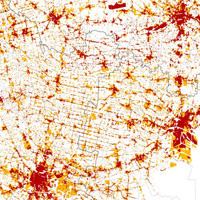The Low-Density Cities: Problems and Management.
Abstract
The essay explores the phenomenon of low-density city. It is divided into three main parts in which are described the characters, the changes and the forms of the phenomenon in different contexts.
In the first part are highlighted character and evolution of the phenomenon in several European and North American contexts, while the second describes the transformation and evolution of a specific context: the territorial system of the central Veneto region. It is a particular example of sprawl occurred in the last forty years that a profound changes in physical, morphological and socio-economic characteristics of the area. In the third part of the essay some examples of policy and planning tools for containing the land consumption and resources in a sustainable way.
Downloads
References
Abbott C. (2002) “Planning a sustainable city. The promise and performance of Portland’s Urban Growth Boundary”, in Squires G.D. (ed.) Urban sprawl. Causes, consequences & policy responses, 207-235.
Anthony J. (2004) “Do State Growth Management Regulations Reduce Sprawl?”, Urban Affairs Review, 39, 376-397.
Bedsworth L.W., Hanak E. (2010) “Adaptetion to Climate Change: A review of Challenges and Tradeoffs in Six Areas”, Journal of the American Planning Association, 76(4), 477-495.
Bonomi A., Abruzzese A. (2004) (a cura di) La città infinita, Bruno Mondadori, Milano.
Burchell R.W. et al. (1998) The Costs of Sprawl-Revisited, Transportation Research Board, Report, 39, National Academy Press, Washington DC.
Burchell R.W., Downs A., McCann B., Mukherji S. (2005) Sprawl Costs. Economic Impacts of Unchecked Development, Island Press, Washington.
Camagni R., Gibelli M.C., Rigamonti P. (2002) I costi collettivi della città dispersa, Alinea Editrice, Firenze.
Cohen J.R. (2002) “Maryland’s “Smart Grawth”. Using Incentives to Combat Sprawl”, in Squires G.D. (ed.), Urban sprawl. Causes, consequences & policy responses, 293-324.
Calthorpe P. (1993) The Next American Metropolis: Ecology, Community, and the American Dream, Princeton, Princeton Architectural Press.
Calthorpe P., Fulton P. (2001) The Regional City. Planning for the end of sprawl, Island Press, Washington.
Clawson M. (1962) “Urban Sprawl and Speculation in Suburban Land”, Land economics, 38(2), 99-111.
Dutton J.A. (2000) New Urbanism. Re-forming the Suburban Metropolis, Skira, Milano.
EEA (2006) Urban sprawl in Europe - The ignored challenge, Report n. 10, EEA.
Ewing R. (1997) “Is Los Angeles-Style Sprawl Desirable”, Journal of the American planning association, 63(1), 107-126.
Fregolent L. (2005) Governare la dispersione, FrancoAngeli, Milano.
Fregolent L. (2011) “La diversitat d’escenaris en la gestió de la ciutat de baixa densita: experiències internacionals”, in Munoz F. (ed.), Estratègies per a la ciutat de baixa densitat. De la contenció a la gestió, Diputació de Barcelona, Barcelona, 449-462.
Fregolent L., Tonin S. (2011) “Lo sviluppo urbano disperso e le implicazioni sulla spesa pubblica”, Economia e società regionale. Oltre il Ponte, 112, 41-60.
Galster G., Hanson R., Wolman H., Coleman S. (2001) “Wrestling Sprawl to the Ground: Defining and Measuring an Elusive Concept”, Housing Policy Debate, 12(4), 681-717.
General Accounting Office (GAO) (1999) Community Development. Extent of federal Influence on “Urban Sprawl” Is Unclear, Report to Congressional Requesters, apr. United States General Accounting Office.
Haag G. (2002) Sprawling cities in Germany, FrancoAngeli, Milano.
Hortas-Rico M., Solé-Ollé A. (2008) “Does Urban Sprawl Increase the Costs of Providing Local Public Services? Evidence From Spanish Municipalities”, Urban Studies, 47(7), 1513-1540.
Indovina F., Fregolent L., Savino M. (2004) (a cura di) L’esplosione della città, Editrice Compositori, Bologna.
Indovina F. (1990) La città diffusa, Daest-IUAV, Venezia.
Indovina F. (2009) Dalla città diffusa all’arcipelago metropolitano, FrancoAngeli, Milano.
Krueger R., Gibbs D. (2008) “Third Wave’ Sustainability? Smart Growth and Regional Development in the USA”, Regional Studies, 42(9), 1263-1274.
Manning R. (2003) “Right-sizing Urban Growth bounderies”, Planning, feb., 22-27.
Munoz F. (2007) “La producción residencial de baja densidad en la provincia de Barcelona (1985-2001)”, in Indovina F. (ed.) La ciudad de baja densidad, Diputació de Barcelona, Barcelona, 51-83.
Nelson A.C., Duncan J.B. (1995) Growth Management Principles and Practices, American planning association, Chicago.
Ottensmann J.R. (1977) “Urban Sprawl, Land Values and the Density of Development”, Land economics, 53(4), 389-400.
Palen J.J. (1995) The Suburbs, McGraw-Hill, New York.
Pumain D. (2004) “Urban Sprawl: Is There a French Case?”, in Richardson H.W., Bee C.H.C. (eds.), Urban Sprawl in Wester Europe ad the United States, Asghate, Aldershot, 137-157.
Real Estate Research Corporation (1974) The Costs of Sprawl: Environmental and Economic Costs of Alternative Residential Development Patterns at the Urban Fringe, Washington D.C., U.S. Government Printing Office.
Savino M. (2003) «Als interstices del desenvolupament (post)metropolitan. Les noves realitats territorials”, Transversal. Revista de cultura contemporània, 20, 35-41.
Secchi B. (2005) La città del ventesimo secolo, Laterza, Roma.
Tosi M.C., Munarin S. (2004) Tracce di città. Esplorazioni di un territorio abitato: l’area veneta, FrancoAngeli, Milano.
Turri E. (2000) Megalopoli padana, Einaudi, Torino.
Travisi C.M., Camagni. R., Nijkamp P. (2009) “Impacts of urban sprawl and commuting: a modelling study for Italy”, Journal of Transport Geography, 18(3), 382-392.
Wheeler S.M. (2008) “The Evolving Metropolitan Region: Historic and Current Built Landscapes”, Journal of Planning Education and Research, 27, 400-416.

Copyright (c) 2014 Tema. Journal of Land Use, Mobility and Environment

This work is licensed under a Creative Commons Attribution 4.0 International License.
Authors who publish in this journal agree to the following:
1. Authors retain the rights to their work and give in to the journal the right of first publication of the work simultaneously licensed under a Creative Commons License - Attribution that allows others to share the work indicating the authorship and the initial publication in this journal.
2. Authors can adhere to other agreements of non-exclusive license for the distribution of the published version of the work (ex. To deposit it in an institutional repository or to publish it in a monography), provided to indicate that the document was first published in this journal.
3. Authors can distribute their work online (ex. In institutional repositories or in their website) prior to and during the submission process, as it can lead to productive exchanges and it can increase the quotations of the published work (See The Effect of Open Access)
